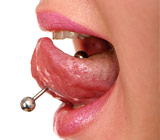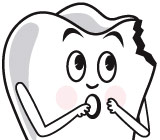Signs and Symptoms of Oral Cancer
 No one wants to hear the word “cancer.” But thanks to advances in detection and treatment, the disease increasingly can be stopped in its earliest stages when it’s most treatable and outcomes are most favorable. Oral cancer accounts for a relatively small 3% of cancers in men and 2% in women, but early detection rates are lagging. Our office screens for oral cancer as part of your regular checkups. Knowing some of the signs and symptoms can help you monitor as well.
No one wants to hear the word “cancer.” But thanks to advances in detection and treatment, the disease increasingly can be stopped in its earliest stages when it’s most treatable and outcomes are most favorable. Oral cancer accounts for a relatively small 3% of cancers in men and 2% in women, but early detection rates are lagging. Our office screens for oral cancer as part of your regular checkups. Knowing some of the signs and symptoms can help you monitor as well.
The main areas where oral carcinomas (cancers) occur are:
- the tongue (most common location, particularly the sides and on the floor of the mouth),
- the lip (especially the lower one),
- the oral cavity (the mouth), and
- the pharynx (back of mouth and throat).
Early Signs
Most oral cancers are preceded by surface changes (lesions) of the oral membranes. In the “precancerous” stage, white or red patches start forming and a non-healing ulcer may appear. The most common locations on the tongue for this to occur are on the sides and underneath on the floor of the mouth. Lip cancers typically develop on the lower lip, usually in people with a history of sun exposure. There has often been prior damage at the site such as scaling and crusting.
Be aware that oral cancers can be mistaken for cold and canker sores, ulcers, minor infections, and even irritations caused by biting or certain types of food. If lesions don’t heal within two or three weeks, there’s a higher likelihood that they are cancerous.
An in-office examination includes the following:
- visual inspection of face, lips, neck and mouth;
- inspection of sides and underneath of tongue and floor of mouth using gauze to gently manipulate the tongue;
- palpation of the floor of the mouth, sides of neck and glands to detect unusual lumps; and
- an “open wide and say ‘Aah’” examination of the back of your throat.
There are some risk factors for oral cancer that can’t be controlled, such as a family history, age and race. But awareness, monitoring for potential signs and seeking prompt attention are always key ingredients in protecting your oral health!
If you would like more information about oral cancer detection, please contact us for a consultation.
Oral Piercings — Tongue & Lip Bolts: Trendy But Dangerous
 Tongue and other piercings are a current fad or trend, but can often lead to unforeseen problems.
Tongue and other piercings are a current fad or trend, but can often lead to unforeseen problems.
Piercing the tongue and installing a metal ornament called a tongue bolt commonly leads to chipped teeth, sensitivity, and pain. More frequently, it can cause problems with the gums, such as recession, inflammation, infection, bone loss, and even nerve damage.
In one case reported by the American Medical Association, a teenager suffered 20 to 30 daily electrical shocks in many areas of her face after having her tongue pierced and installing a tongue bolt. A neurologist found that the bolt irritated the nerves to her tongue, causing the symptoms. After the bolt was removed, the shocks and symptoms ceased and her tongue healed.
Having the bolts placed may be painful. The tongue is rich in nerves and blood vessels and a lot of bleeding can occur, which can be difficult to stop. Think about how painful it is when you bite your tongue or lip accidentally. And tongue and lip bolts are not generally placed by health professionals or under sterile conditions.
If you are considering getting an oral piercing, make an appointment with us to discuss all the possible ramifications before you make the decision to go ahead. If you already have an oral piercing, be sure to come in for frequent checkups.
Contact us today to schedule an appointment to discuss your questions about oral piercings.
If Your Child Chipped A Tooth, What Should You Do?
 Nearly every parent and caregiver has experienced that almost instantaneous sick feeling when they see that their child has been injured, especially when it is an injury to the mouth and teeth. For some, it is just a bloody lip; however, if the accident chipped a tooth, then you may have a completely different situation on your hands. If the nerve of the tooth has not been damaged, you needn’t worry too much — a composite (plastic) tooth-colored restoration that is actually bonded to the tooth is an ideal material for repairing most broken or chipped teeth. See us as soon as possible to assess the extent of injury, so that proper and appropriate action can be taken.
Nearly every parent and caregiver has experienced that almost instantaneous sick feeling when they see that their child has been injured, especially when it is an injury to the mouth and teeth. For some, it is just a bloody lip; however, if the accident chipped a tooth, then you may have a completely different situation on your hands. If the nerve of the tooth has not been damaged, you needn’t worry too much — a composite (plastic) tooth-colored restoration that is actually bonded to the tooth is an ideal material for repairing most broken or chipped teeth. See us as soon as possible to assess the extent of injury, so that proper and appropriate action can be taken.
An additional reason why bonding with composite resin may be the ideal choice for repairing a child’s chipped tooth is that it can be custom created in virtually any shade so that it perfectly matches the damaged tooth and the surrounding teeth. It is also far less expensive than a crown, an important factor to consider when repairing a primary (baby) tooth that will eventually fall out to make room for a permanent tooth. If the injury is to a permanent tooth, a composite resin still may be ideal to use as a restoration until your child or teenager has stopped growing or playing contact sports. This is because your teenager may be too young for a more permanent restoration such as a crown or porcelain veneer.
An important, proactive step you can take to be prepared for the next time your child has a dental injury is to download Dear Doctor’s Field-side Pocket Guide for Dental Injuries. This handy, quick reference guide is a must have for athletes, parents, caregivers, teachers, coaches or anyone who is often in an environment where a mouth injury is likely to occur. Knowing what to do and how quickly you must respond can make the critical difference between saving and losing a tooth.




